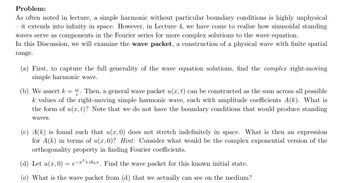Question

Transcribed Image Text:Problem:
As often noted in lecture, a simple harmonic without particular boundary conditions is highly unphysical
- it extends into infinity in space. However, in Lecture 4, we have come to realise how sinusoidal standing
waves serve as components in the Fourier series for more complex solutions to the wave equation.
In this Discussion, we will examine the wave packet, a construction of a physical wave with finite spatial
range.
(a) First, to capture the full generality of the wave equation solutions, find the complex right-moving
simple harmonic wave.
(b) We assert k = . Then, a general wave packet u(x, t) can be constructed as the sum across all possible
k values of the right-moving simple harmonic wave, each with amplitude coefficients A(k). What is
the form of u(x, t)? Note that we do not have the boundary conditions that would produce standing
waves.
(c) A(k) is found such that u(x, 0) does not stretch indefinitely in space. What is then an expression
for A(k) in terms of u(x, 0)? Hint: Consider what would be the complex exponential version of the
orthogonality property in finding Fourier coefficients.
(d) Let u(x, 0) =e-²+ikoa. Find the wave packet for this known initial state.
(e) What is the wave packet from (d) that we actually can see on the medium?
Expert Solution
This question has been solved!
Explore an expertly crafted, step-by-step solution for a thorough understanding of key concepts.
This is a popular solution
Trending nowThis is a popular solution!
Step by stepSolved in 4 steps

Knowledge Booster
Similar questions
- It's a quantum mechanics question.arrow_forwarda particle is confined to move on a circle's circumference (particle on a ring) such that its position can be described by the angle ϕ in the range of 0 to 2π. This system has wavefunctions in the form Ψm(ϕ)= eimlϕ where ml is an integer. Show that the wavefunctions Ψm(ϕ) with ml= +1 and +2 are ORTHOGONAL Show full and complete procedure. Do not skip any steparrow_forwardBy employing the prescribed definitions of the raising and lowering operators pertaining to the one-dimensional harmonic oscillator: x = ħ 2mω -(â+ + â_) hmw ê = i Compute the expectation values of the following quantities for the nth stationary staten. Keep in mind that the stationary states form an orthogonal set. 2 · (â+ − â_) [ pm 4ndx YmVndx = 8mn a. The position of particle (x) b. The momentum of the particle (p). c. (x²) d. (p²) e. Confirm that the uncertainty principle is satisfied for all values of narrow_forward
- Please don't provide handwritten solution ..... Determine the normalization constant for the wavefunction for a 3-dimensional box (3 separate infinite 1-dimensional wells) of lengths a (x direction), b (y direction), and c (z direction).arrow_forwardThe wavefunction for the motion of a particle on a ring is of the form ψ=NeimΦ . Evaluate the normalization constant, N. Show full and complete procedure in a clear way. DO NOT SKIP ANY STEParrow_forwardConsider a finite potential step with V = V0 in the region x < 0, and V = 0 in the region x > 0 (image). For particles with energy E > V0, and coming into the system from the left, what would be the wavefunction used to describe the “transmitted” particles and the wavefunction used to describe the “reflected” particles?arrow_forward
- Solve the problem for a quantum mechanical particle trapped in a one dimensional box of length L. This means determining the complete, normalized wave functions and the possible energies. Please use the back of this sheet if you need more room.arrow_forward(a) Write down the wave functions for the three regions of the potential energy barrier (Figure 5.25) for E < U₁. You will need six coefficients in all. Use complex exponential notation. (b) Use the boundary conditions at x = 0 and at x = L to find four relationships among the six coeffi- cients. (Do not try to solve these relationships.) (c) Sup- pose particles are incident on the barrier from the left. Which coefficient should be set to zero? Why?arrow_forwardProve in the canonical ensemble that, as T ! 0, the microstate probability ℘m approaches a constant for any ground state m with lowest energy E0 but is otherwise zero for Em > E0 . What is the constant?arrow_forward
arrow_back_ios
arrow_forward_ios